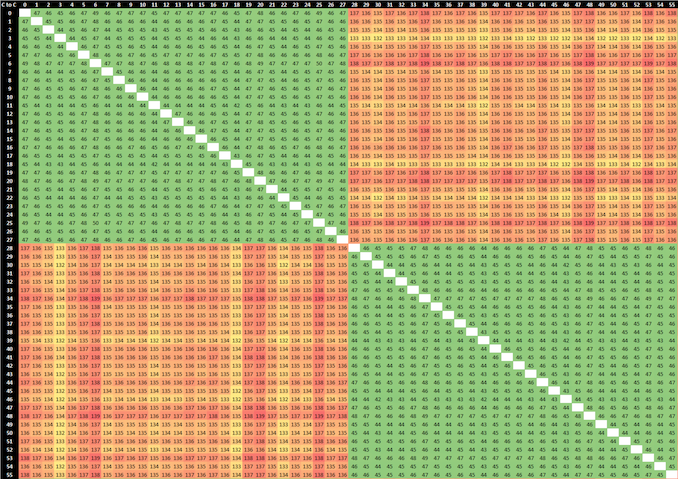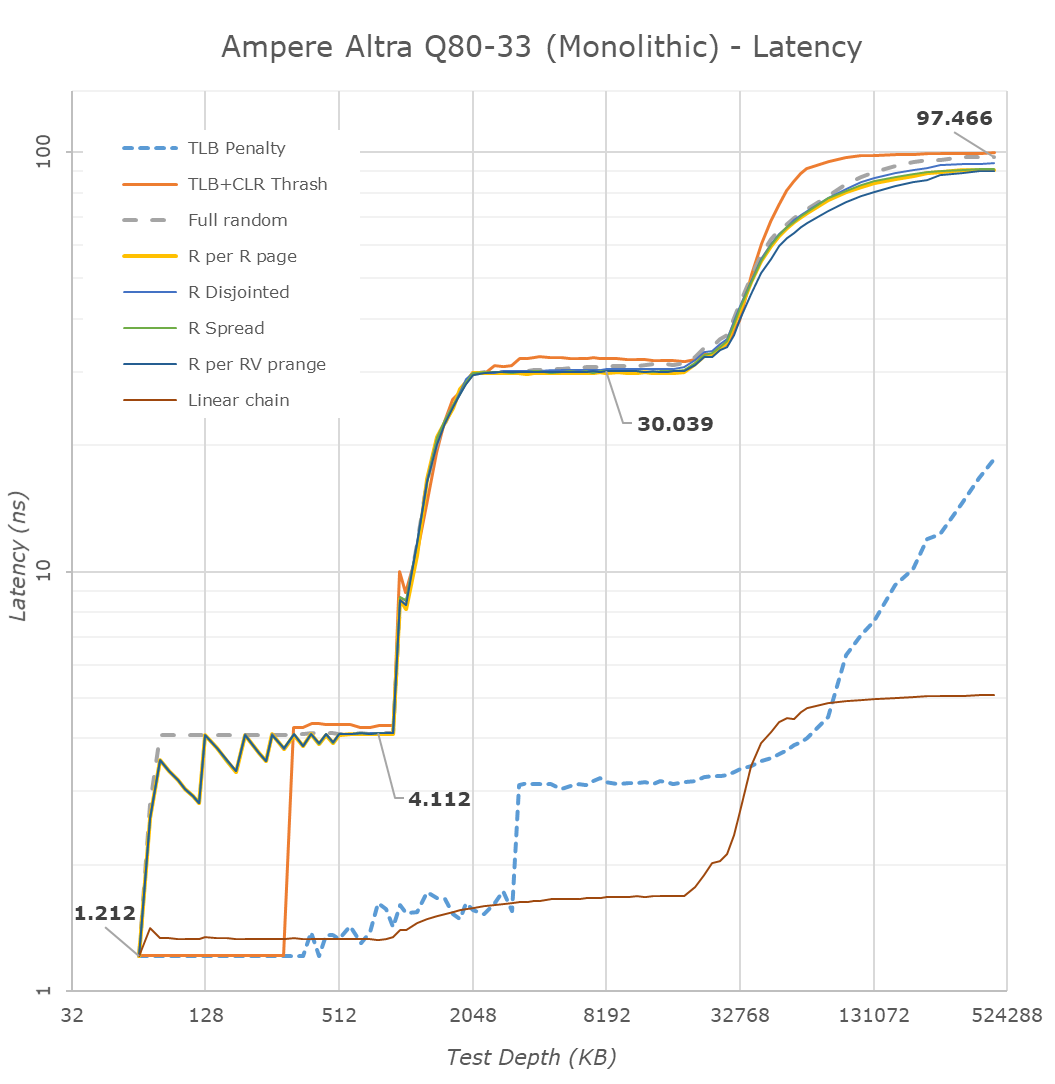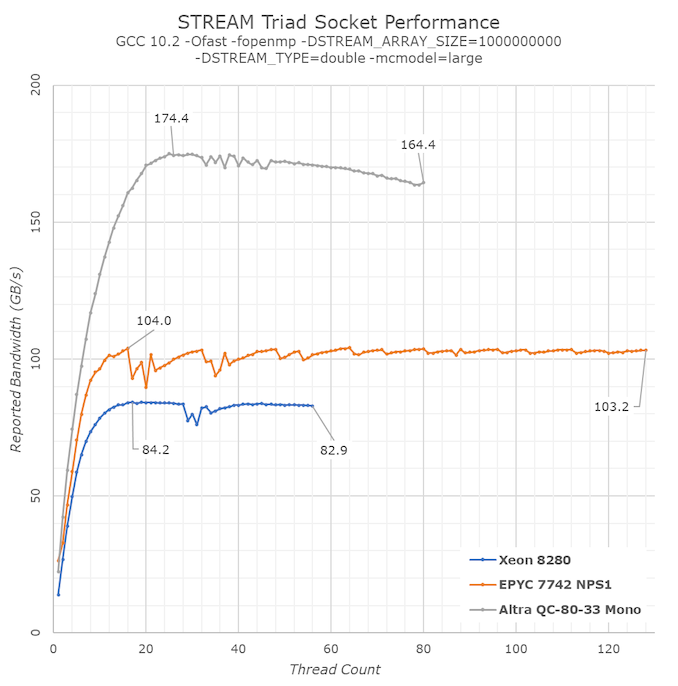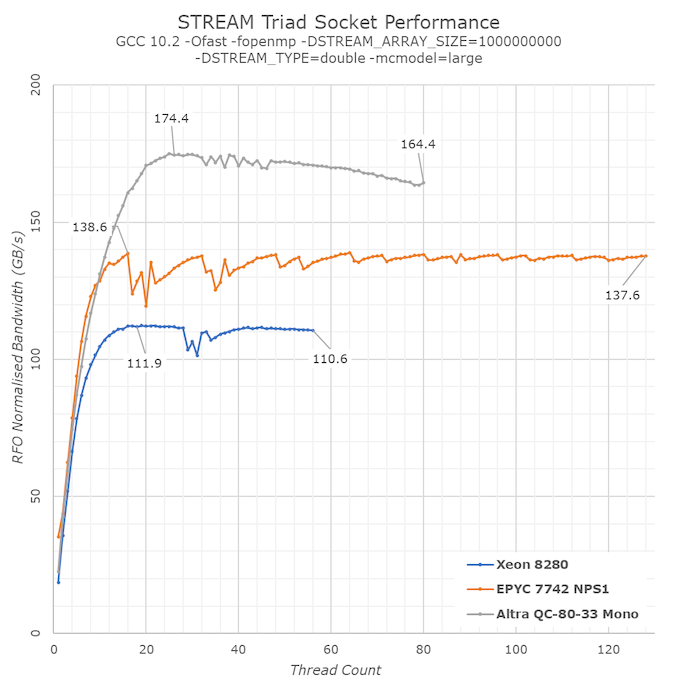The Ampere Altra Review: 2x 80 Cores Arm Server Performance Monster
by Andrei Frumusanu on December 18, 2020 6:00 AM EST- Posted in
- Servers
- Neoverse N1
- Ampere
- Altra
Topology, Memory Subsystem & Latency
We move onto our usual suite of synthetic tests, trying to expose some of the key hardware characteristics of the systems. The first topic to address is the chip’s physical core topologies, and how inter-core communications take place in the system, particularly interesting since we have access to 2-socket systems.
Due to the sheer core-count of the systems, these result matrices are quite huge so I recommend opening up the full resolution images to inspect the detailed results.
As a reminder, our inter-core bounce test consists of an initial main thread which allocates the synchronisation cache line on the core that the executable is spawned on – we try to fix this to the first NUMA node / CPU group of the first socket. This in turn spawns two ping-pong threads which bounce around based on the shared cache line, and we change the affinity of the threads across the system to test out the various core-to-core latencies. Because of the usage of a common shared cache line – usually how real software works, we’re essentially testing core-to-cacheline-to-core – an important distinction to make for some systems which have different cache line placement and cache coherency algorithms.
We had already tested the Graviton2 earlier in the year, where we made the distinction between usage of software which compiles to plain Armv8 and exclusive load and excusive store instructions, and the newer Armv8.1 compiled variant of the test which takes advantage of LSE (Large System Extensions) which includes atomic operation instructions – we’re still using the latter variant here on the Altra system.
At first view, in the top-left quadrant of the matrix which represents 80 cores within one single socket, things seem quite similar to the Graviton2 – but not quite. On the Amazon chip’s results what we saw is that the shared cache line remained static within the chip’s mesh structure, meaning cores nearer to that cache slice of the L3 resulted in better latencies compared to cores which were further away.
On the Altra system, the results are quite different here as first of all they’re all more even though it’s a bigger chip with a larger mesh. I tested out the system in a quadrant mode (more on this later) so this might be the reason why things are behaving quite differently to the Graviton2. Interesting to see is this diagonal of results across quarters of a socket landing in at 27ns. I suspect this essentially would represent core-pairs within a single “CPU Tile” within a single mesh node across the chip. If so, then that’s definitely a very different behaviour to the Graviton2.
It actually slipped my mind to re-test this with the chip set to a single monolithic NUMA node so that’s hopefully something I’ll revisit and check if it behaves more similarly to the Graviton2.
When looking at socket-to-socket latencies, we’re looking at latencies of around 350-360ns, which frankly isn’t all that great compared to AMD and Intel’s current multi-socket cache-coherency implementations.
What’s actually quite terrible here, is the inter-core latencies of within the remote socket from the synchronisation shared cache-line. We still very evidently see those 27ns results which we again suspect is within a core-pair CPU tile, but for other cores in the system this actually ends up with a massive latency of around 650ns.
Essentially what the system is doing here, is that one core is sending out a request across the socket, having to be translated from the native AMBA CHI protocol to CCIX, cross the socket, get translated back to CHI to the resident cache line of the initial controller thread, and go back again to the remote socket and incur even further several cache coherency translation penalties.

2-Socket Intel Xeon Platinum 8280
Comparing the Altra results to an Intel Xeon Platinum 8280 Cascade Lake 2S system, the latencies within a socket aren’t too different – both implementations are after all monolithic chips with mesh architectures. Keep in mind that the Xeon system here will boost up to 4GHz during the test as we’re only loading 2 cores.
Inter-socket latencies for the Xeon lands in at around 135ns which is very good and a fraction of the Altra system. The chips here use Intel’s UPI interface links and protocols – 3x 10.4GT/s interfaces. In theory the bandwidth here is less than the Altra system, however because it’s all running on the same native protocol across sockets it doesn’t have to incur any penalties as the Altra.
Most importantly, latencies within the second socket are identical to the first socket, meaning the coherency protocols are transferring the shared cache line ownership across sockets even though these are two different NUMA nodes.
Finally, AMD’s EPYC 7742 here performs middle-of-the-road across the implementations, with the biggest difference being that it’s not a monolithic cache hierarchy across a whole chip, but rather within 4-core CCX clusters within the CPU chiplets, which are then further divided into physical quadrants on the I/O die which connects the 8 chiplets of a single-socket package.
Socket-to-socket, the Rome chip essentially doubles up the worse in-socket latencies. Within the remote socket, AMD is able to locally copy ownership of the shared cache-line within a CCXs, but access latencies between CCXs within the remote socket still seem to have to communicate back to the home socket with similar latencies as the socket-to-socket core figures.
Still, even AMD’s unorthodox system vastly outperforms the socket-to-socket communication of the Ampere Altra by not having to translate between different coherency protocols – that’s the advantage of owning the IP and designing the protocols yourself. Ampere here would have to rely on Arm to release a native AMBA CHI-like implementation to support inter-socket coherency across two mesh systems.
Memory Latency
In terms of memory latency, the new Altra Q80-33 and its siblings should be quite straightforward.
Starting off with the monolithic native results of the Altra, we can see the full cache hierarchy of the chip, with the 64KB L1D and 1MB L2 caches of the Neoverse N1 cores, as well as the 32MB L3 cache of the mesh.
What stands out here compared to the Graviton2 results earlier in the year, is that the Altra’s advanced prefetchers are essentially all disabled by default, and all our access patterns are behaving essentially identical, simply exposing the hardware latencies, with only the next-line prefetcher still being active for linear streams.
That’s interesting, and maybe a decision made due to the sheer core-count of the system – every bit of bandwidth is needed for feed all the cores with usable data, so there’s no room speculative prefetching.
DRAM memory latency of the system is excellent at 97ns and below that of the Graviton2 – though one big note we have to make here is that the Altra system is running CentOS with 64KB pages by default, which will give the system some advantage in TLB misses.
Compared to a Xeon 8280, the Altra system still loses out in memory latency even though both are monolithic chips, and the Xeon is actually running slower DDR4-2933 versus DDR-3200 of the Altra and EPYC.
In NPS1 mode, the EPYC 7742 has to interleave memory accesses across all of its I/O die quadrants which on top of the chiplet architecture results in larger memory latency penalties, up to 133ns here at our equal depth measurement point.
One speciality of the Altra is that Ampere actually offering various operating modes when running the chip in different NUMA configurations: You can either treat the chip as a native large monolithic design, just like the hardware is designed, or you can subdivide the mesh and memory controllers into either two hemispheres, or four quadrants. The point of subdividing the chip this way even though it’s a monolithic design seems at first counter-productive, but Ampere says there are practical benefits to this.
The first benefit would be that this allows for better segregation of workloads across cloud workloads. A customer deploying an Altra system in the cloud would want to run multiple virtual machines on a single chip – subdividing the chip into quadrants here has the practical benefit of completely eliminating effects of noisy-neighbours within that quadrant. Furthermore, this actually also subdivides the cache of the mesh system, meaning that the 32MB get divided into 8MB quadrants, something which one can immediately see in the graph.
Beyond reducing cross-chip traffic and reducing noisy neighbours in VM systems, the division slightly also improves latencies. For example, DRAM accesses go down from 97ns to 93ns because a CPU only accesses its two-nearest memory controller channels instead of accessing the further across-the-chip controllers. Similarly, the L3 latency also slightly goes down from 30.0ns to 27.6ns as it has to interleave accesses just across the nearest located quadrant cache node slices, reducing wire latency.
Of course, because the Altra is still a monolithic chip, the benefits aren’t quite as significant as what we see on AMD’s EPYC Rome system which sees DRAM latency go down from 133ns to 117ns due to it no longer hopping around Infinity Fabric nodes across the I/O die quadrants.
Memory Bandwidth
Multi-core memory bandwidth is a topic I don’t really enjoy, due to nuances of different systems and how memory behaves across large systems. The data that you want to showcase has to serve a pre-determined purpose – either you’re trying to benchmark things from a software perspective, or you want to expose hardware capabilities. STREAM is a benchmark that has been abused quite a bit over the years in that it crossed this boundary between scopes far too much, especially across multi-socket systems. The vanilla version is meant to benchmark memory within a single memory node, which is exactly what we’ll be doing. On top of that, we’re also compiling a vanilla copy of the benchmark using plain optimisation flags, further avoiding the rabbit-hole of apples-and-oranges comparisons that are done out there in the wild.
Having that in mind, let’s check out the STREAM Triad results of the various processors:
What first comes to light of course the difference between the new Altra processor, and the x86 platforms which appear to be performing much worse. It’s again at this point where we have to disambiguate what we’re measuring, software performance, or hardware behaviour?
From a software standpoint, the Altra indeed vastly outperforms the competition, and the reason for this is an architecture and microarchitecture one. The Neoverse-N1 cores in the Altra system are able to take advantage of Arm’s weaker memory model: the CPU cores will detect that they’re working on a streaming workload, meaning it’s going over large amounts of data with no re-use of the previous results. The CPU thus automatically converts its memory write operations into non-temporal ones.
The difference between “regular” RFO (Read For Ownership) memory writes and non-temporal writes is that the former incurs further cache coherency operations on the part of the hardware. For example, writing a 64B cache-line to memory write from a software perspective here actually results in 128B of hardware traffic as the core has to first read out the target cache line before it can write to it.
For STREAM, for example in the Triad test whose kernel is a[j] = b[j]+scalar*c[j];, the test assumes 3 memory operations, one write to a[j] and two reads out of b[j] and c[j], where in reality for x86 systems it’s actually 4 memory operations, thus 1.33x the reported bandwidth from the test. The memory copy kernel which is c[j] = a[j]; assumes there to be 2 memory operations, while in reality there’s 3, thus 1.5x higher.
It’s possible to compile STREAM to outright explicitly use non-temporal stores on x86 systems, with the test using instructions that hint out to the core to avoid checking the cache line to be written. Essentially this is what various ICC compiled and optimised variants of STREAM do.
Unfortunately, when using such optimised variants of the benchmark you’re no longer testing apples to apples software performance, but rather something else, and tread into the realm of trying to measure what the hardware is doing. In my view that’s not what STREAM is meant for. I have custom tests that showcase vastly higher bandwidth than STREAM on all platforms, but they’re doing something completely different in terms of design.
In any case, even if we were to compensate with the 1.33x or 1.5x factors for the x86 systems, they don’t reach the memory performance that the Altra Q80-33 is showcasing here. Arm’s smart usage of the architecture’s memory model flexibility and ability to transforms arbitrary streams into non-temporal operations is a real-world benefit to all software. As a note, this behaviour is also present on mobile cores from Arm from the Cortex-A76 onwards, Samsung’s cores from M4 onwards, and from this year’s Apple Firestorm cores in the A14 and M1.
















148 Comments
View All Comments
mode_13h - Thursday, December 31, 2020 - link
Isn't Blender included in SPECfp2017 as 526.blender_r? Or is that something different?Teckk - Friday, December 18, 2020 - link
Whoever decided on naming these products — fantastic job. Simple, clear and effective.Maybe you can offer some free advice to Intel and Sony.
Calin - Friday, December 18, 2020 - link
The answer to the question of "how powerful it is" is clear - more than good enough.The real question in fact is:
"How much can they produce?"
AMD has the crown in x86 processor performance, but this doesn't really matter very much as long as they can build enough processors only for a part of the market.
jwittich - Friday, December 18, 2020 - link
How many do you need? :)Bigos - Friday, December 18, 2020 - link
64kB pages might significantly enhance performance on workload with large memory sets, as the TLB will be up to 16x less used. On the other hand, memory usage of the Linux file system cache will also increase a lot.Would you be able to test the effect of 64kB vs 4kB page size on at least some workloads?
Andrei Frumusanu - Friday, December 18, 2020 - link
It's something that I wanted to test but it requires a OS reinstall / kernel recompile - I didn't want to get into that rabbit hole of a time sink as already spent a lot of time verifying a lot of data across the three platforms over a few weeks already.arnd - Friday, December 18, 2020 - link
I'd love to see that as well. For workloads that use transparent huge pages, there should not be much difference since both would use 2MB huge pages (512*4KB or 32*64KB), plus one or more even larger page sizes, but it needs to be measured to beThe downsides of 64KB requiring larger disk I/O and more RAM are often harder to quantify, as most benchmarks try to avoid the interesting cases.
I've tried benchmarking kernel compiles on Graviton2 both ways and found 64kB pages to be a few percent faster when there is enough RAM, but forcing the system to swap by limiting the total RAM made the 64kB kernel easily 10x to 1000x slower than the 4kB one, depending on the how the available memory lined up with the working set.
abufrejoval - Friday, December 18, 2020 - link
Thank you for the incredible amount of information and the work you put into this: Anandtech's best!Yet I wonder who would deploy this and where. The purchasing price of the CPU would seem to become a rather miniscule part of the total system cost, especially once you go into big RAM territory. And I wonder if it's not similar with the energy budget: I see my larger systems requiring more $ and Watts on RAM than on the CPUs. Are they doing, can they do anything there to reduce DRAM energy consumption vs. Intel/AMD?
The cost of the ecosystem change to ARM may be less relevant once you have the scale to pay for it, but where exactly would those scale benefits come from? And what scales are we talking about? Would you need 100k or 1m servers to break even?
And what sort of system load would you have to reach/maintain to have significant energy advantages vs. x86 iron?
Do they support special tricks like powering down quadrants and RAM banks for load management, do they enable quick standby/actvation modes so that servers can be take off and on for load management?
And how long would the benefits last? AMD has demonstrated rather well, that the ability to execute over at least three generations of hardware are required to shift attention even from the big guys and they have still all the scaling benefits the x86 installed base provides.
These guys are on a 2nd generation product, promise 3rd but essentially this would seem to have the same level of confidence as the 1st EPIC.
askar - Friday, December 18, 2020 - link
Would you mind testing ML performance, i.e. python's SKLearn library classes that can be multithreaded (random forest for example)?mode_13h - Sunday, December 20, 2020 - link
MLPerf?